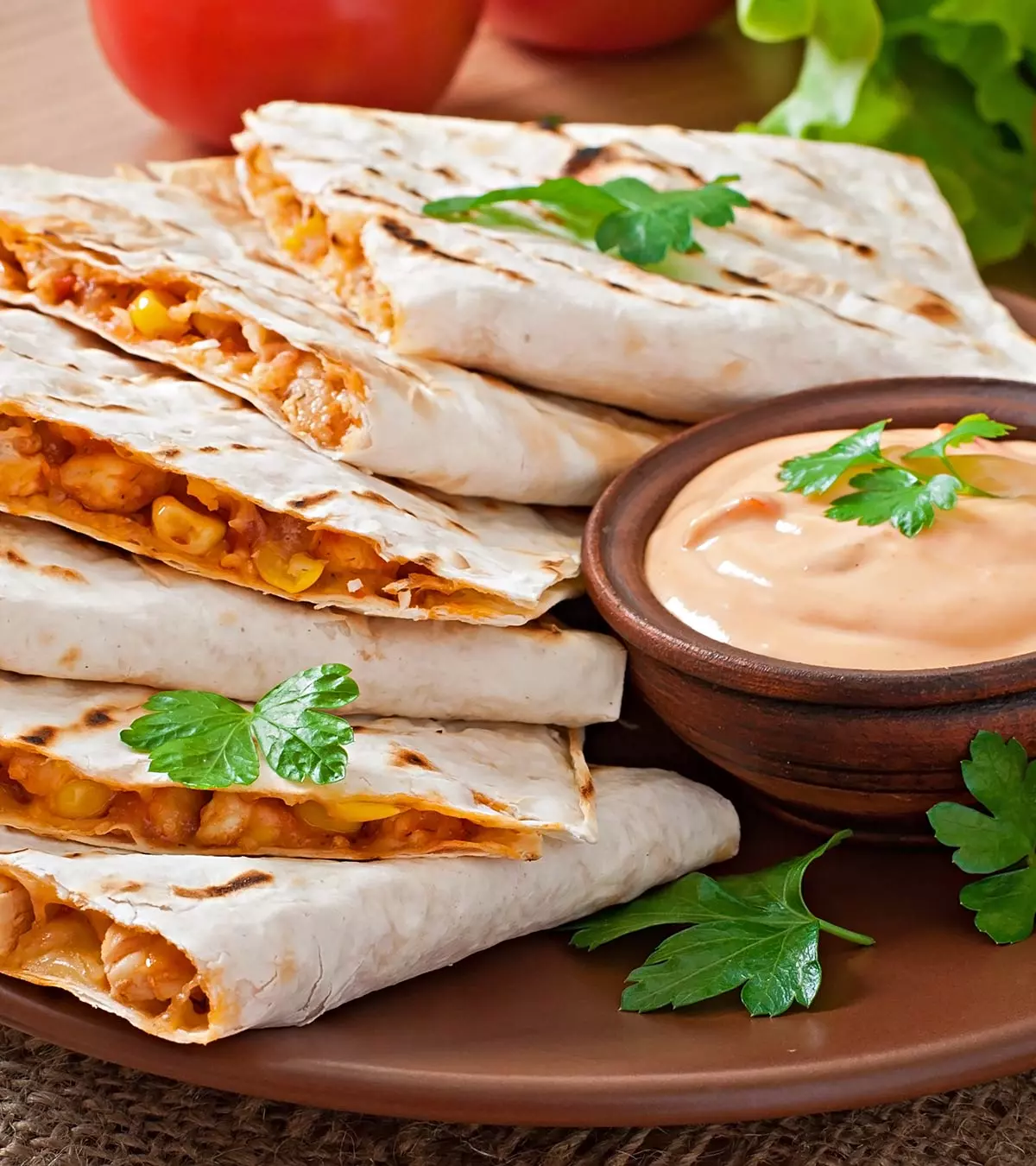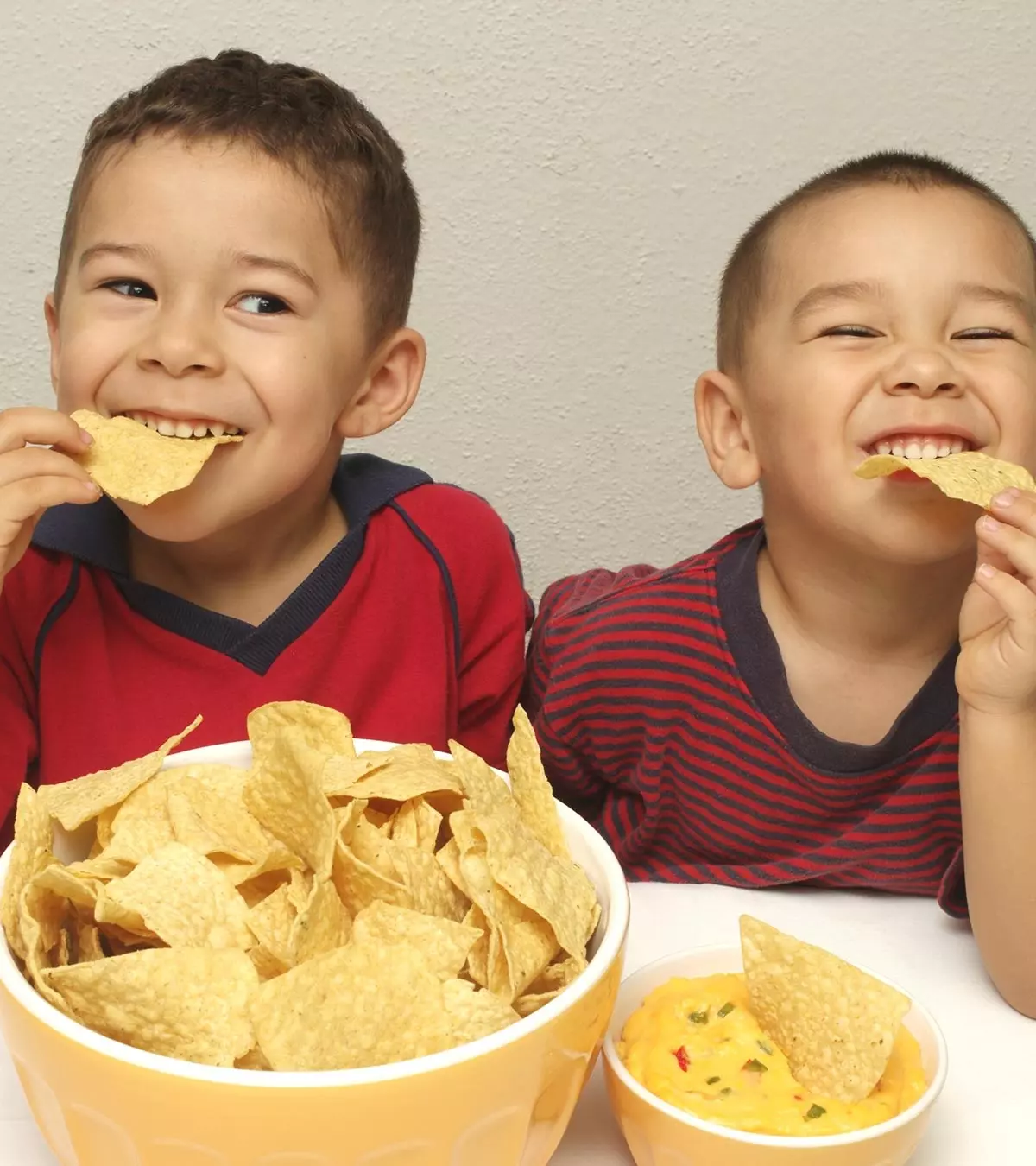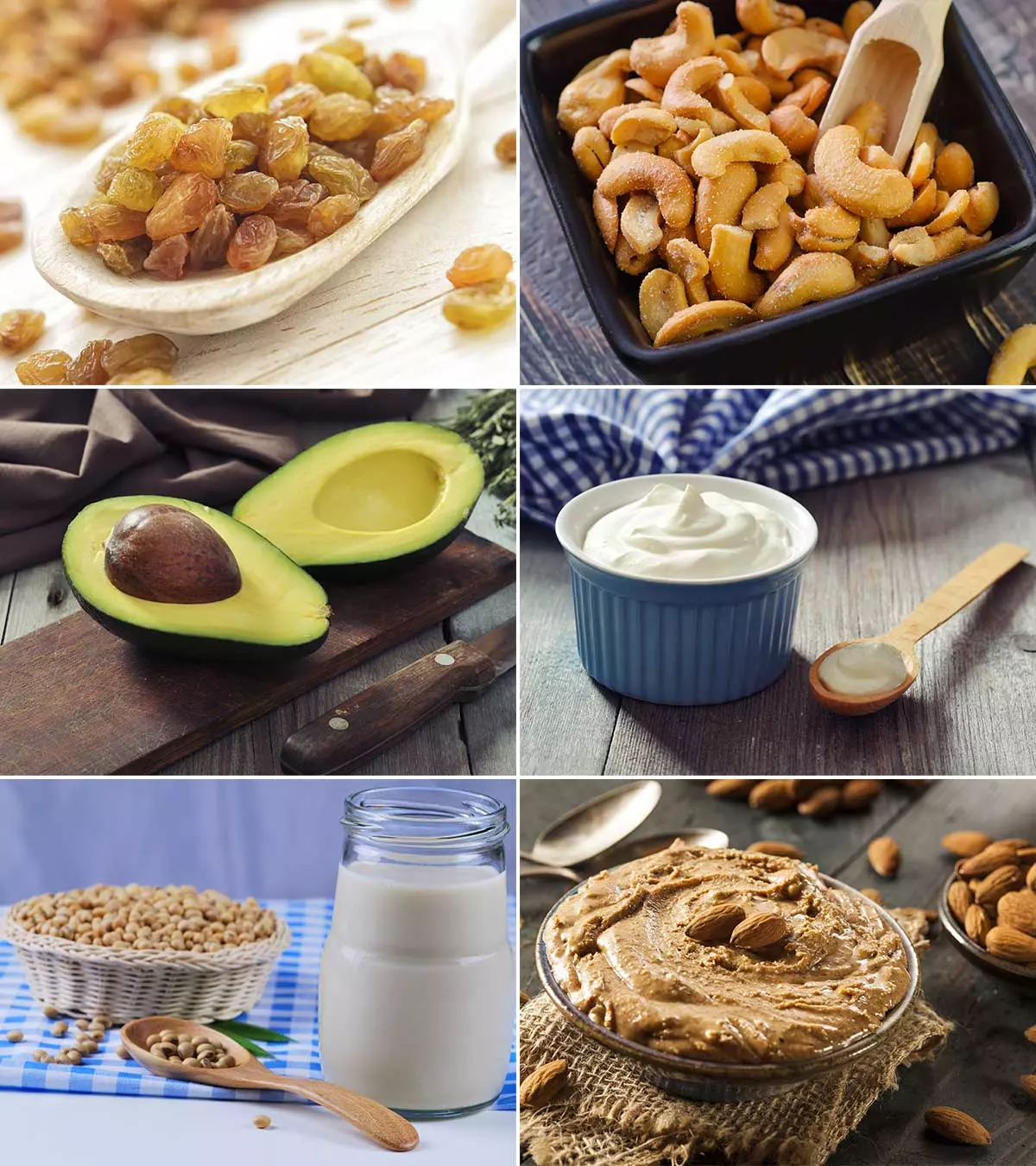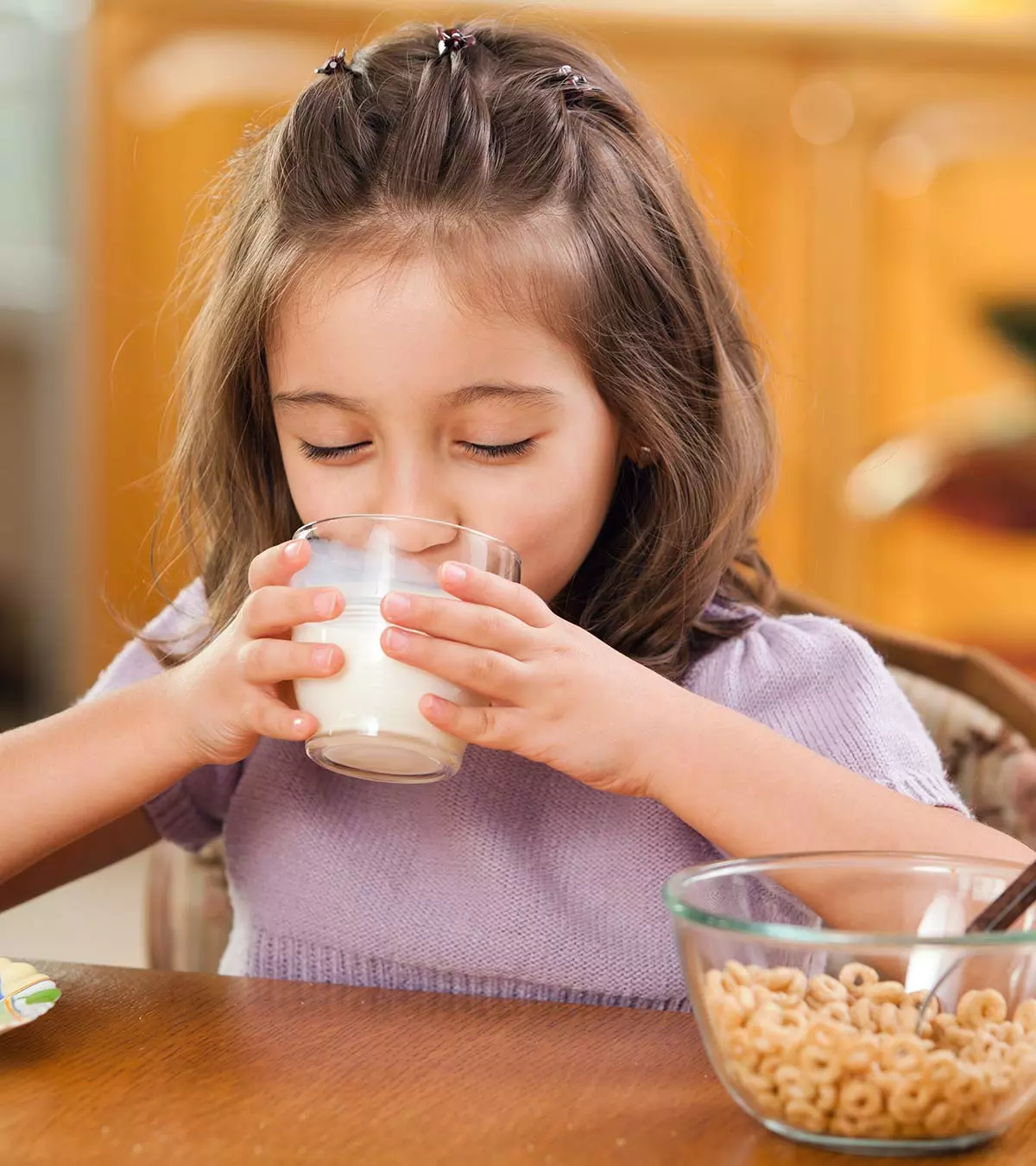
Image: Shutterstock
Apples are undoubtedly popular in every region of the world and have also ranked among the top three most grown fruits globally (1). This post on apples for kids will help give you an insight into the benefits and uses. Apples come in various colors and varieties and are known to be available all around the year. You should have also heard of a famous saying, “An apple a day keeps the doctor away.” Learn about the benefits of apples for children and how you can incorporate them into their diet to make it interesting for them.

Key Pointers
- Consuming apples rich in bioactive compounds, vitamins, minerals, carbohydrates, fiber, and natural sugars with the peel promotes good health.
- Apples aid weight management, improve bone and brain health, promote intestinal cleansing, and reduce cardiovascular issues.
- Consuming apples may cause swelling, oral itchiness, allergic dermatitis, tooth enamel erosion, and pesticide-induced problems.
- Apples can be incorporated into a child’s meal by chopping, blending, or baking them and combining them with other ingredients.
Interesting Facts About Apple For Kids
- Whether red, green, or golden, all apples look as beautiful as flowers. But did you know they are part of the Rose family? Isn’t it a real connection!
- How many varieties of apples exist? You might say a 100. But actually, there are almost 8,000 different varieties of apples, the largest variety of fruit to exist.
- The world’s fastest-growing plant is bamboo, but for apples, it takes 4-5 years to produce their first fruit, phew!
- Although apple harvest in orchards is seasonal, they are available year-round due to the use of cold storage. However, it’s important to note that apples go through a natural dormancyiA phase marked by a temporary slowdown of growth and development activities, especially during an environmental change. period after being harvested.
- An apple helps in your good health and longevity, but an apple tree itself has a life expectancy of 100 years.
- Apple is popularly referred to as the forbidden fruit of Eden. But this is not mentioned anywhere in the Bible.
- Apple is often marketed to be rich in micronutrients like vitamin C and potassium. But the total amount of vitamin C found in apples is far less than the amount found in guava, oranges, and strawberries.
- It is generally believed that once an apple is cut, it gets brown due to bacterial contamination. But is that so? No, the browning of a cut apple is nothing but enzymatic browning. Enzymatic browning is a plant’s defense system that keeps the apple safe from pests and pathogens (2).
- PhotophobiaiHeightened sensitivity to bright light, causing discomfort or pain to an individual. , claustrophobia, and then apple phobia. Yes, you heard it right. Malusdomesticaphobia is a term used for people who fear either apples or eating apples.
- Can apples float? Oh, yes, they can. But how? Simple science – 25% of an apple’s volume is air.
 Did you know?
Did you know?This fact list can be endless, but as you learned some facts about apples, let’s just start knowing some nutritional details.
Nutritional Value Of Apple
Whole apples (i.e., apples with peel) have various nutrients in good amounts. Several essential nutrients and bioactive compounds in the fruit are present immediately under the apple’s skin. Therefore, it is advisable to eat this juicy fruit with the peel.
Below are the nutrients that you would find in a medium-sized apple (182 grams) corresponding to the daily requirement of nutrients on a per-day basis for kids.
| Name | Amount | RDA (per day) |
|---|---|---|
| Water | 156g | – |
| Energy | 94.6Kcal | – |
| Carbohydrate, by difference | 25.1g | 130g |
| Fiber, total dietary | 4.37g | 16.8 – 22.4g |
| Sugars, total including NLEA | 18.9g | – |
| Calcium, Ca | 10.9mg | 1000 – 1300mg |
| Magnesium, Mg | 9.1mg | 8 – 10mg |
| Phosphorus, P | 20mg | 500 – 1250mg |
| Potassium, K | 195mg | 3800 – 4500mg |
| Sodium, Na | 1.82mg | 1900 – 2200mg |
| Vitamin C, total ascorbic acid | 8.37mg | 25-45mg |
| Folate, total | 5.46µg | 200-300µg |
| Choline, total | 6.19mg | 250-375mg |
| Vitamin A, RAE | 5.46µg | 400-600µg |
| Vitamin K (phylloquinone) | 4µg | – |
Source: US Department of Agriculture (3) (4)
As per the approximate composition, the apple does not seem to be exceptional. However, the US National Health and Nutrition Examination Survey (NHANES) 2003–2010 recommends the inclusion of an apple as a component of a child’s overall healthy diet (5).
Health Benefits Of Apples For Kids
The health benefits of apples are attributed to the fiber and bioactive compounds such as quercetiniA plant pigment that gives color to fruits, vegetables, and grains and has anti-inflammatory and antioxidant effects. , catechiniA type of antioxidant that protects the cells from free-radical damage. , phloridziniA compound present in apples that are believed to reduce sugar load and manage type 2 diabetes. , and chlorogenic acidiAntioxidants in apples that are believed to have anti-diabetic, anti-inflammatory, and anti-carcinogenic effect. present in it (6).
- Weight management: 100 grams of apples contains 85 grams of water. This makes apples a low-calorie fruit. Besides, it has considerable fiber. These two vital components make it a good choice to keep your kid away from weight gain concerns (7). However, regular physical activity with a well-balanced diet is also needed to manage weight.

- Digestive health: Apples are a source of both soluble and insoluble fiber. The insoluble fiber present in the skin of the apple holds water in the intestine and adds bulk. It makes the food movement in the intestine smooth. Besides, it aids in cleansing the intestine (8).
- Bone health: Some studies have shown that long-term consumption of apples might help in restoring bone health (7). It could be due to the presence of minerals such as calcium and magnesium.
- Cognitive health: Apple is known to contain phenolic compounds that have shown effectiveness against free radical damage (9). It enhances cognitive health in babies by improving their memory and learning. Research is ongoing on the potential of apples to maintain and improve brain health.
- Prebiotic support: Gut microbiota profile can be altered with the help of a diet. However, for that, the type and quantity of food that reach the colon has an important part to play. Apple has insoluble fiber, such as cellulose and hemicellulose, that acts as prebiotic. It reaches the colon and possibly supports the enhancement of the gut microbiota (10).
- Cardiovascular health: Apples have a considerable amount of soluble fiber, such as pectin. Pectin is considered effective in preventing the accumulation of cholesterol in blood vessels. It eventually reduces the incidence of cardiovascular diseases (9). Besides fiber, apples have bioactive compounds, such as flavonoids that may further reduce cardiovascular risks (10).
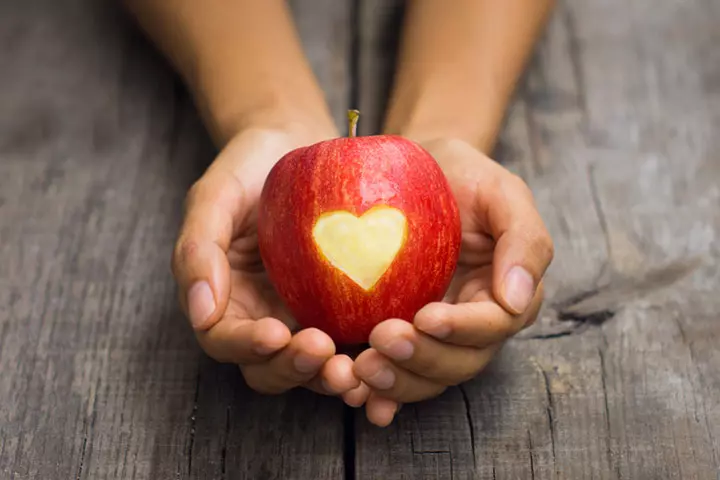
- Antioxidant property: A research study showed that the antioxidant activity of unripe apples is higher than ripe ones (11). However, ripe apples have the highest proportion of free phenolics that are more readily absorbed by the body. The high antioxidant activity could be useful in preventing chronic diseases like cancer (12). It is important to note here that the antioxidant activity varies as per the variety of the apple. Also, higher antioxidant activity is attributed to apple peel than apple flesh.
Overall, apples are easy-to-eat, portable food children can easily carry and eat anytime during the day. However, it may pose some risks.
Studies show that apple varieties with higher phenolics have higher antioxidant activity. The graphical representation below shows the total phenolics in different apple varieties commonly consumed in the US. According to the data, the Fuji apple contains the highest amount of phenolics, followed by the Red Delicious and Gala apples.

Phenolic content in different apple varieties
Source: Apple phytochemicals and their health benefits; Nutrition Journal/BMCApple definitely is a good choice for your kids. However, it may pose some risks.
Are There Any Health Risks Of Apple For Kids?
Consumption of apples is seldom associated with health concerns. However, there could be some potential risks.
- Oral allergy syndrome: An oral allergy syndrome (OAS) is a form of contact allergy dermatitis, which mostly occurs among those who are allergic to the birch tree pollen. A few proteins found in an apple may trigger the allergic reaction, which displays symptoms such as swelling and itchiness of the mouth, lip, tongue, and throat (13). However, not all varieties of apple are allergic. Also, cooked apples may not pose the risk of allergy (14).
- Damage to tooth enamel: The American Dental Association suggests that frequent consumption of acidic foods can erode tooth enamel (15). Apple does have some amount of acidity, and a study noted that the erosion caused by the fruit was even greater than orange (16). Apple fruit juice could be more acidic than the whole fruit (17). While the juice can be avoided, the benefits of eating the whole apple outweigh the risks. Fruits seldom cause extensive tooth decay by themselves. Nevertheless, a child can take a sip of plain water after eating an apple to neutralize the acidity and it’s always nice to rinse your mouth after eating a meal or a snack
- Pesticides: Apples rank on the top of Environmental Working Group’s (EWG’s) Dirty Dozen list. The fruits are estimated to harbor an average of 4.4 pesticide residue, including the presence of diphenylamine, a regulated pesticide in the US and Europe. Although the US considers diphenylamine safe, the European food safety authority showed concerns about the adverse health effects of diphenylamine-treated fruit. The pesticide can cause the formation of compounds called nitrosamines. Some studies have found that eating foods containing nitrosamines could elevate the risk of stomach and esophageal cancers (18). Therefore, it is recommended to eat organic apples as much as possible after washing them properly.
Giving the whole fruit, with peel, is the best way to eat an apple. However, if your children are not a fan of an apple, you may try some interesting recipes for them.
Apple Recipes For Kids
Below are some delicious and healthy recipes that include apple and help provide nutrition to the child.
1. Apple quinoa bowl

This recipe is an easy addition to your kid’s breakfast. It is also one of the most nutritious apple recipes for kids and contains essential nutrients in the right amount.
You will need:
- 500ml low-fat milk
- 1 cup quinoa (uncooked)
- 1tbsp unsalted butter
- 1 medium apple (peeled and thinly sliced)
- 1 cup water
- 2tbsp brown sugar
- ½tsp ground cinnamon
- 1 cup berries (optional) – for garnishing
How to:
- Take a saucepan and put it over medium heat. Add milk and bring it to a simmer.
- Now add quinoa to milk and stir. Reduce the flame at this point to low.
- Let the mix simmer for about 20 minutes or until the quinoa is tender. Stir frequently and make sure to scrape the bottom of the pot to keep the milk from burning.
- Once the quinoa is tender, remove the saucepan from the heat and keep it aside.
- Meanwhile, take a skillet and put it over medium heat. As it heats, put butter and melt it.
- Add apple slices to melted butter and cook until the apples turn soft. While stirring continuously, add water, brown sugar, and cinnamon. Cook until the liquid thickens.
- Put the quinoa in the serving bowl and spoon the apples, remaining juices, and berries on top of the quinoa.
Tip:
Another variation of this dish can be made with low-fat yogurt. You can add a handful of seeds and nuts as well to intensify the nutritive value of the dish multi-folds.
2. Whole grain apple crumble

This recipe is ideal for packing a school lunch or serving a wholesome after-school meal. With its fiber-rich, crunchy, and crispy texture, this dish is a smart choice to steer children away from readily available junk food options.
You will need:
- 2 apples, peeled (thinly sliced)
- 50g brown sugar
- 30g almond meal
- 1tsp vanilla paste
- 75g multigrain flour
- 50g unsalted butter
- 50g almond chunks
- 50g brown sugar
How to:
- Grease a baking sheet. Coat the apples with a mix of sugar, almond meal, and vanilla paste. Place them in layers on the tray.
- Take flour in a large bowl. Add butter to it and mix them well. While mixing, add almond chunks and brown sugar as well.
- Once the mix is ready, add the vanilla paste to the mix.
- Add the prepared mix on top of the apple slices. Sprinkle a few almond chunks on top of the apple.
- Place the baking tray in an oven at 230-degree celsius for 20 minutes.
- Pack it in the box or serve fresh with chilled yogurt.
Tip:
To provide some variety to this recipe, you can add millet flour instead of multigrain flour. However, the baking temperature needs to be set as per the millet you desire to add. Also, seeds and nuts trail mix can also be added to the recipe to intensify the nutritive value of the recipe.
 Quick tip
Quick tip3. Apple and chia seeds smoothie
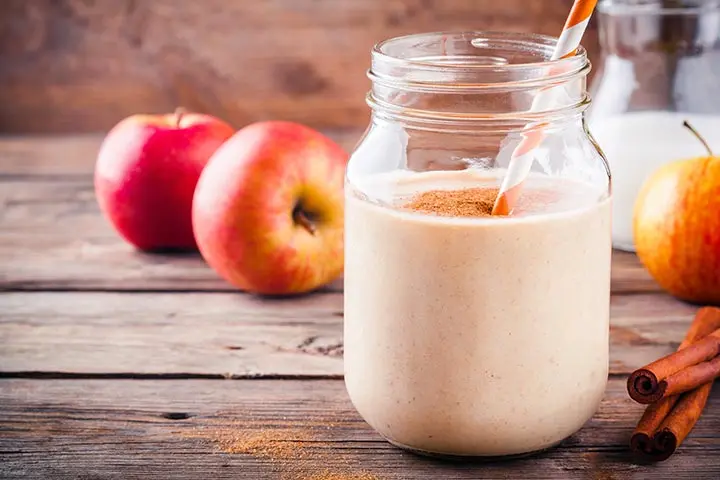
Apple and chia seeds smoothie is a great addition to your kid’s daily meal. A serving of smoothie can be refreshing. This smoothie is also packed with protein and healthy fat to meet your child’s daily nutritional requirements, making it a good addition to healthy meals for kids.
You will need:
- 1 apple (chopped)
- 1 cup unsweetened yogurt
- 1tsp peanut butter
- 1 cup mixed nuts
- 1tsp chia seeds
How to:
- Add apples, yogurt, mixed nuts, and peanut butter in a blender.
- Blend everything together until you get a smooth flowing mixture. You can add some water to mix in case the recipe feels too thick.
- Now take a glass and add chia seeds to it. Fill the glass with the smoothie and keep the glass in the fridge for 30 mins.
- Serve it chilled.
Tip:
This recipe can be prepared with coconut or almond milk as well. Variety and moderation is the key to success. So keep trying different healthy alternatives of each ingredient that could help you make the recipe more nutritious.
4. Baked apples
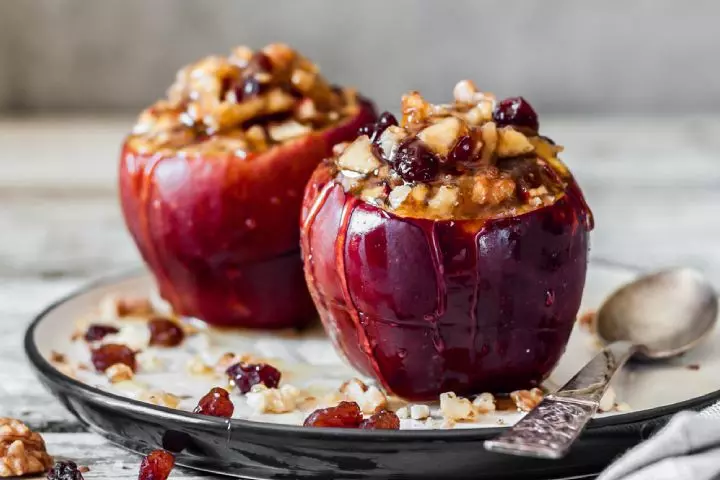
Baked apples are a healthy and filling snack option for kids. The nuts, resins, cranberries, and oats in the recipe enhance this yummy dish’s nutritional value.
You will need:
- 4 apples (sweet-tart varieties work best)
- 1tsp cinnamon powder
- ¼tsp nutmeg powder
- ¼ cup brown sugar
- ¼ cup rolled oats
- ¼ cup pecans (chopped to small pieces)
- ¼ cup mixed raisins and cranberries (chopped)
- 2tbsp butter (softened)
- ¾ cup boiling water
How to:
- Set the oven at 375°F for preheating
- Beat the butter with a fork and mix in cinnamon, nutmeg, and brown sugar
- Add the oats, followed by pecans, resins and cranberries. This mixture serves as the filling.
- Use an apple corer or a knife and spoon to core the apples. Dig out the core till ¾ down into the apple without breaking the bottom surface
- Stuff the cored apples with the filling and place them on a baking dish.
- Pour boiling water at the bottom of the baking dish
- Bake apples until they look softened (about 30 to 45 minutes)
- Remove from the oven and pour the juices over the apples.
- Serve warm.
Tip:
This recipe may include your choice of nuts and dry fruits. Brown sugar may be omitted altogether, and you may use sweeter apples with dates as an ingredient for filling.
Apart from these, you could also try making seasonal apple sauce by cooking cored apples, sugar, water, and cinnamon, one of the ways Cara Carroll, the primary teacher and mother, ensures the kids get to taste apples. She notes, “Making applesauce with my class is another seasonal favorite. I love how it makes my classroom smell, and I absolutely LOVE the experience it gives my kids….many of them never have or never will get to do this again. They talk about this all year long!!! “I also give my kids the recipe to take home to their parents just in case they want to try and recreate the deliciousness at home (i).”
Frequently Asked Questions
1. At what age can a child have an apple?
You can begin giving apples to your baby as early as six months old. Begin with one or two tablespoons of plain and strained apple puree (19).
2. Is two apples a day too much?
According to the US Centers for Disease Control and Prevention, the following is the recommended daily intake of fruits for children (20). Depending on the fruit’s size, if the chopped apples exceed the recommended quantity, you may adjust the portion size accordingly.
| Age group | Female | Male |
|---|---|---|
| 2–3 years | 1 cup | 1 cup |
| 4–8 years | ½–1 cup | ½–1 cup |
| 9–13 years | 1½ cup | 1½ cup |
3. Which type of apple is good for children?
Although different varieties of apples have different tastes, they are all nutritious for your children. So, choose the ones that your children love the most. However, while choosing the apples, remember to select fresh and local ones. Since the local varieties travel less distance, they retain more nutrition (21).
Apples are nutritious and contain many essential vitamins and minerals that assist in a child’s proper growth and development. There are many ways to include apples in a child’s diet. These apple recipes will be a surprising treat if your child has a sweet tooth. And if your child doesn’t like the fruit, we have added a few “apple facts for kids” and its nutritional profile to grasp their attention. So read out the facts and try these recipes to make this fruit a part of their diet.
Infographic: Facts About Apple For Children
“An apple a day keeps the doctor away.” We all know how healthy apples are for both children and adults. But do you want to know more about the fruit besides its benefits? We bring interesting facts about apples that will pique your child’s interest in them and encourage them to eat more. Illustration: Momjunction Design Team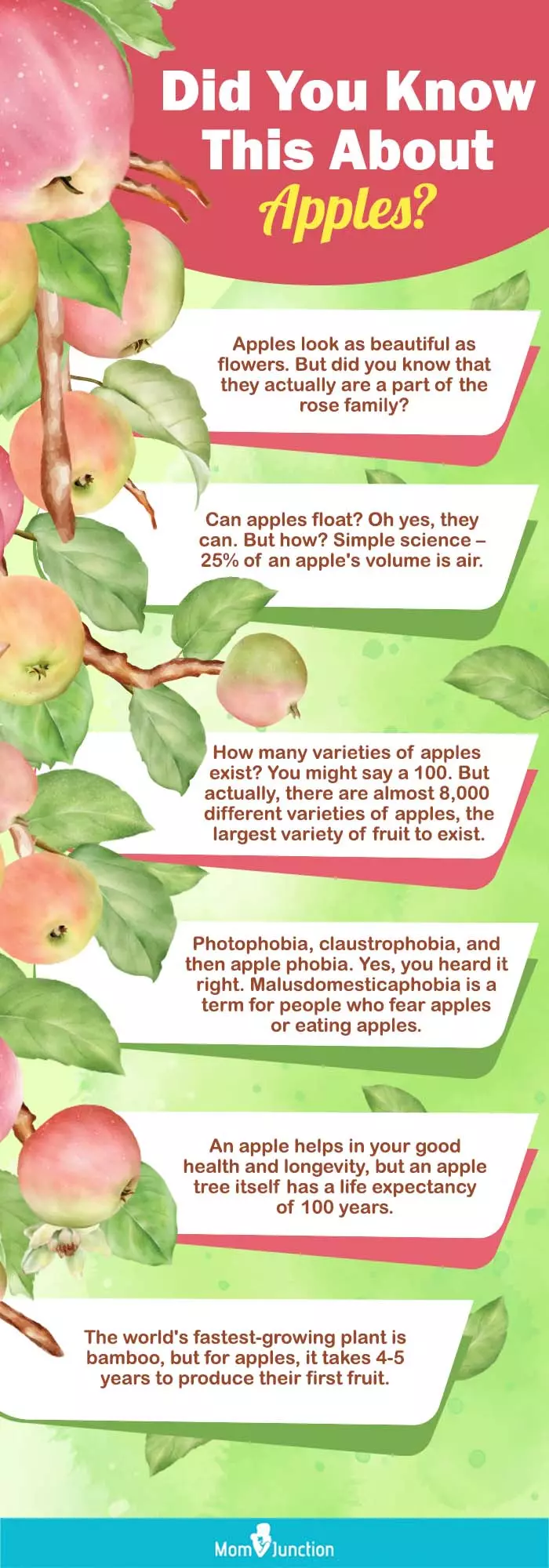
Illustration: Interesting Apple Facts For Kids & Its Health Benefits
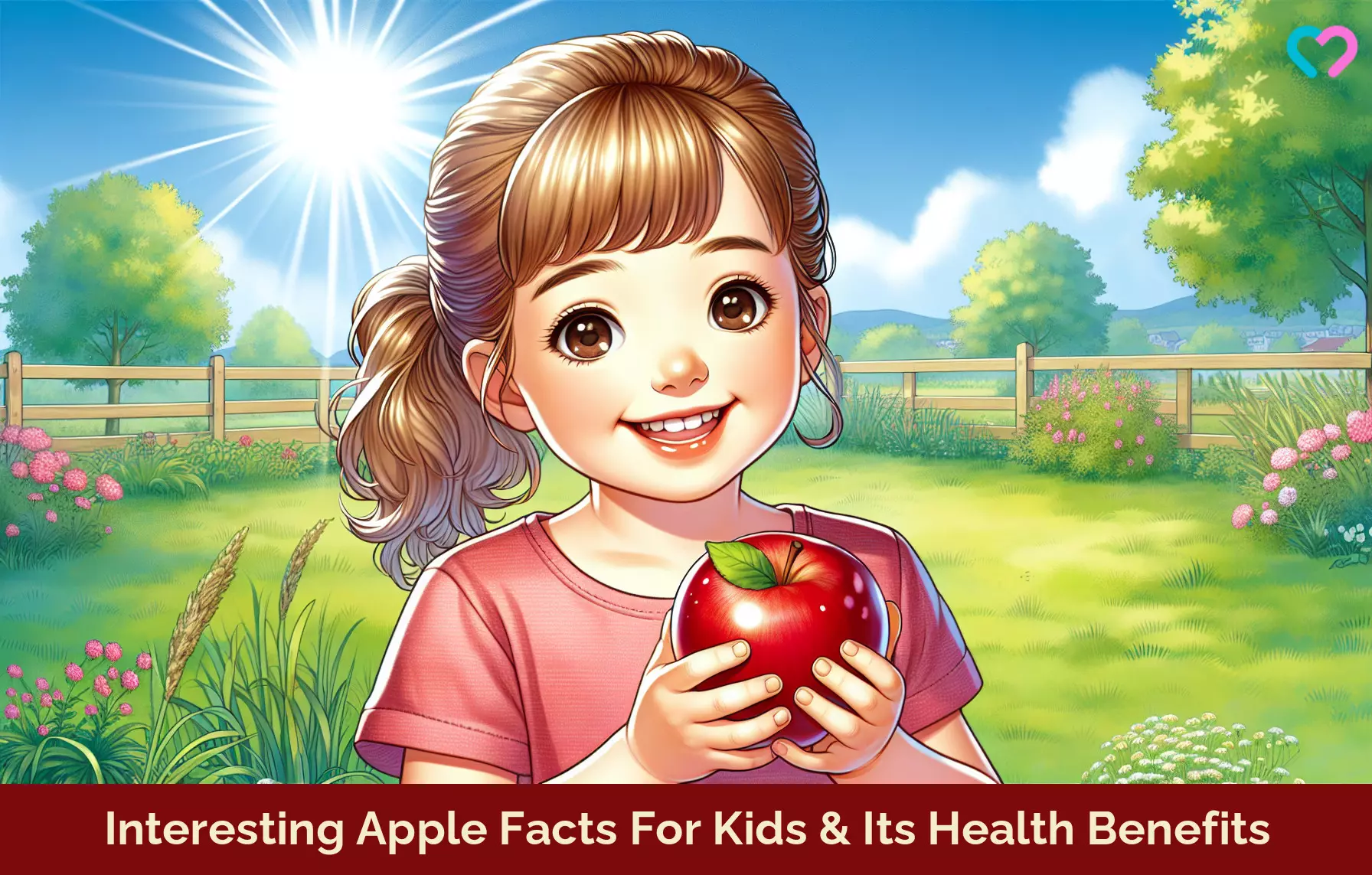
Image: Dall·E/MomJunction Design Team
Hey kids! Watch this video for some fun facts about apples. Learn about the different types, how they grow, and their many uses. Get ready for an apple-filled adventure!
Personal Experience: Source
MomJunction articles include first-hand experiences to provide you with better insights through real-life narratives. Here are the sources of personal accounts referenced in this article.
i. Apple fun for everyone!https://justcaracarroll.com/apple-fun-for-everyone/
References
1. Apples; Harvard T.H Chan School of Public Health
2. Curiosities: Why do apple slices turn brown?; University of Wisconsin-Madison
3. Apples, raw, with skin (Includes foods for USDA’s Food Distribution Program); USDA
4. Dietary Guidelines For The Americans 2015-2025; USDA
5. Carol E. O’Neil et al., Consumption of apples is associated with a better diet quality and reduced risk of obesity in children: National Health and Nutrition Examination Survey (NHANES) 2003–2010; National Center For Biotechnology Information
6. Jeanelle Boyer and Rui Hai Liu; Apple phytochemicals and their health benefits; National Center For Biotechnology Information
7. Dianne A. Hyson; A Comprehensive Review of Apples and Apple Components and Their Relationship to Human Health; National Center For Biotechnology Information
8. Apple Nutrition; University of Illinois Extension
9. Shalika Rana and Shashi Bhushan; Apple phenolics as nutraceuticals: assessment, analysis and application; National Center For Biotechnology Information
10. Athanasios Koutsos et al., Apples and Cardiovascular Health—Is the Gut Microbiota a Core Consideration?; National Center For Biotechnology Information
11. Aleksandra Duda-Chodak et al., Antioxidant Activity Of Apples-An activity of Maturity Stage And Fruit Part; ACTA
12. Jeanelle Boyer and Rui Hai Liu; Antioxidants of Apples; Semantic Scholar
13. Oral Allergy Syndrome (OAS); American Academy of Allergy Asthma & Immunology
14. Apple Allergen Facts, Symptoms, and Treatment ; Thermo Fisher Scientific
15. Top 9 Foods That Damage Your Teeth; Mouth Healthy; American Dental Association
16. Grobler SR et al., The degree of enamel erosion by five different kinds of fruit.; National Center For Biotechnology Information
17. Stefan Zimmer et al., Influence of Various Acidic Beverages on Tooth Erosion. Evaluation by a New Method; National Center For Biotechnology Information
18. Apples Doused With Chemical After Harvest; Environmental Working Group
19. Feeding Guide for the First Year; Stanford Children’s Health
20. Progress on Children Eating More Fruit, Not Vegetables; CDC.
21. Which apples are healthiest; Cleveland Clinic
Community Experiences
Join the conversation and become a part of our nurturing community! Share your stories, experiences, and insights to connect with fellow parents.
Read full bio of Jyoti Benjamin
Read full bio of Swati Patwal
Read full bio of Rohit Garoo
Read full bio of Shinta Liz Sunny







